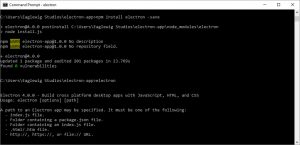
Now that we have all of our files in place, we can run our Electron app. This is useful not only for debugging, but also for testing that your app is working as expected. When this file is rendered, it will display the versions of Node, Chrome, and Electron that you are running.
Electron api demos install#
The JavaScript file will be called index.js and will contain the following code: const. Clone the Quick Start repository git clone Go into the repository cd electron-quick-start Install the dependencies and run npm install & npm start Try powerful experiments with Electron Fiddle Electron Fiddle lets you create and play with small Electron experiments. To make our basic Electron app, we'll just need to create a JavaScript file and a basic HTML file. Whats new in version 2.0.1 Delta between version 2.0.0 and version 2.0.1 Source: Github Commits: 9bdf397519641a7b3673bb703646eb913e31b54c, Novem7:17 PM. To do this using npm, you can use the following command: npm install electronĪnd with that, you should have Electron installed and ready to go. It also refers to the HID protocol, a standard for bi-directional communication between a host and a device that is designed to simplify the installation procedure. To do this, run the following command: yarn add electron A Human Interface Device (HID) is a type of device that takes input from or provides output to humans. Feel free to change the name of the project, but we'll keep it as app. This will create a package.json file for you. Inside your app folder, run the following command: npm init -y Because Electron is a Node app, we'll need to initialize a npm project.
Electron api demos how to#
If you don't have them installed, follow our how to install Node guide.

''' from flexx import flx from import Splines from import Twente from import Drawing class Demo (flx. Here's the Electron app that we will be building: Our Electron app running. ''' A demo with few lines of code with some fancy widgets, which works as an exported app, so it can be embedded e.g. In this tutorial, we will learn how to set up Electron, create a basic hello world example, run it on your local machine natively, and try out demos of Electron with Electron Fiddle. With Electron, you can write native desktop applications in JavaScript, HTML, and CSS and have them run on all major desktop operating systems, such as macOS, Windows, and Linux.Įlectron works by bundling in Chromium, the same rendering engine that powers Chrome, and use the V8 JavaScript engine to run your Node code.Įlectron is essentially a stand-alone Chrome tab that you can build desktop apps in. You can choose either the default preset which has Babel and ESlint or you can select the needed features manually. Open a new terminal and run the following command: vue create electron-vue.
Electron api demos software#
Created by GitHub, Electron is used by a wide variety of open source and proprietary software projects, including Discord, Slack, Visual Studio Code, and many more.Įlectron is important because it made native desktop applications a lot easier due to its ability to support JavaScript, one of the world's most popular programming languages. After installing the Vue CLI, let's proceed to create a Vue project. Electron is a cross-platform desktop application framework based on web technologies.


 0 kommentar(er)
0 kommentar(er)
